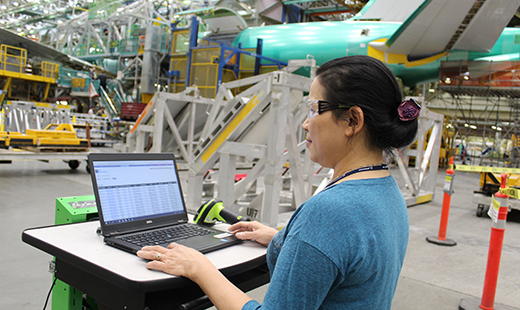Smart factories are the future. But are you ready?
The explosive growth of Internet of Things (IoT) technologies is not only transforming the world around us, it’s also accelerating digital transformation for factories and supply chains. This Industrial IoT (IIoT) empowers organizations to work smarter through connectivity, automation and data management to gain the competitive edge.
However, digital transformation can be a tough journey if you’re not prepared. Organizations often struggle with interoperability issues as they work to connect “all things” across their enterprise – including sensors, hardware and business systems with differing protocols to communicate and analyze data across multiple networks.
ESI: The Gateway to the Industrial IoT

Whether you’re looking to optimize your manufacturing operations or gain insight into the supply chain, Enterprise Sensor Integration (ESI) can accelerate your digital transformation journey today. Our award-winning ESI technology is a smart digital platform for the IIoT that solves critical business problems for our customers.
Harnessing the power of Big Data and analytics, ESI helps bridge interoperability gaps through sensor fusion. ESI ensures end-to-end visibility for assets and processes, generating major savings due to improved inventory control, reduced asset loss and accelerated production rates.
Let our team of IIoT experts help you prepare for this exciting new world of data as it is transformed into business intelligence.
Enabling Technologies
ESI is a smart middleware solution that intelligently connects people, machines and data across the enterprise. The technology integrates sensors and systems that track, monitor and control assets, and workflow processes to increase asset visibility, quality and situational awareness across your operations.
The IIoT computing platform is designed with a modular, microservices-based infrastructure that provides the flexibility and scalability to add new features. It also features a dynamic user interface through its front-end applications suite, including intuitive, map-centric views of actionable data.
As a “sensor-agnostic” solution, ESI integrates a wide range of sensors regardless of sensor or hardware type, including Radio Frequency Identification (RFID) tags, GPS transponders, Mesh networks, BLE (Bluetooth Low Energy) and Wi-Fi technology to track and manage assets.
ESI also integrates with Enterprise Resource Planning (ERP) systems, Manufacturing Execution Systems (MES) and Material Requirements Planning (MRP) systems to automate workflow processes. The technology operates in the cloud or on dedicated servers, from single factories to global operations.


Benefits
- Standardization across the enterprise
- Automated processes that reduce labor and manual inputs
- Improved inventory control; reduced asset misplacement and loss
- Improved productivity with reduction of manual inputs and decreased assembly time
- Increased asset visibility with mapping applications
- Enhanced situational awareness with real-time alerts
- Real-time alerts that improve safety
Asset Management
ESI helps you locate assets with data at your fingertips.
The Asset Management capability ensures continuous operational visibility of assets throughout their lifecycle – from induction through inventory tracking, repair and disposition at end of life.
- Track & trace all tagged assets within the corporate infrastructure
- Track calibration and asset lifecycle history
- Display asset grouping by job, area, responsibility, function, etc.
- Find your asset on a map-centric user interface
- Provides automated inventory in storage and in motion, minimizing inventory by exception

Tool Management
ESI provides accountability of your tools; minimizes Foreign Object Debris (FOD).
The Tool Management capability provides the full scope of tool induction, assignment and tool crib check out/check in functions – as well as process management for calibration, inspections, transfers and loans, repair, replacement, lifecycle cost and disposition at end of life. Major features include:
- Check-out, check-in and hand-off off tools from one person to another at the tool room or in the field
- Corporate tool search function for available and/or substitutable tools
- Disposition of tools for maintenance, repair, calibration, inspection, resale, destruction, etc.
- Automated tool box/cabinet inventory

Device Management
ESI makes it easy to remotely track and manage IoT devices at scale.
- Connect IoT devices – from single to thousands of devices – at a centralized location or across a distributed enterprise
- Manage health of the devices from a centralized location with status boards, as well as on-demand reconfiguration and reboot capabilities
- Configure IoT devices to include revision history so you can revert to a known good state
- Manage data collection, processing and timing
- Optimize load balancing for edge devices to maximize data flows
The Device Management capability enables organizations to remotely diagnose, track and manage the functionality of IoT devices and data flows at an enterprise-level down to a single-edge device. It supports processes including authenticating, configuring, monitoring and maintaining devices to maintain the health, security and connectivity throughout their lifecycle.

Work-in-Progress Tracking
ESI tracks Work in Progress (WIP) to achieve complete real-time visibility into all manufacturing processes.
- Improves traceability, productivity and accuracy of manufacturing processes
- Ensures efficient inventory management to better manage demand forecast of stock over time
- Helps reduce production costs through accurate consumption tracking and reporting
- Improves quality by reducing human errors throughout the production process
The automated WIP capability tracks work order information for manufacturing production runs -- capturing status and quality of materials in real-time as they flow through the production line. It immediately reports any deviations and exceptions that occur to avoid costly mistakes. WIP also reports on the total costs incurred to make the final product, from the beginning inventory on hand to the ending inventory – taking into account scrap, loss and waste of raw materials. The ERP captures the data to support auto-replenishment of stock, ensuring a just-in-time inventory flow through the supply chain to support the actual demand forecast.


Use Case - Creating Effective IIoT Ecosystems
From tool management to auto replenishment, learn how to create effective IIoT Ecosystems to connect your enterprise. To initiate your journey to smart factory transformation, think big, but start small with individual use cases. Then repeat the process until you achieve full integration among the various use cases. This allows you to create an effective IIoT infrastructure, which will provide scalability and an agile development approach.
Click the links below to see examples of effective use cases within an IIoT ecosystem.
Auto Replenishment Use Case
ESI provides a unique Auto-Replenishment capability that ensures stock is replenished just-in-time and expedites payment to suppliers. It works with a Twin Bin storage system equipped with RFID tags. When the bottom bin is depleted of stock/parts, a separator shelf is pulled out allowing the parts to fall into the bottom chamber. An RFID-driven flag pops up and sends a reorder signal to the ERP to validate the requisition against the demand forecast. Once validated, the ERP notifies supplier who fills the order and ships the stock by multimodal transportation.
When the container arrives at the factory, an RFID reader at the loading dock generates an auto-receipt for each item, signaling the ERP for auto-payment. The material handler then replenishes the bin and resets the replenishment tag. Every step of this replenishment ecosystem is fully automated, which reduces waste, and improves supply chain velocity and cash flow management.
Parts Attrition Use Case
The goal of any manufacturing operation is to effectively calculate the rate of parts/material attrition – also known as part wastage – to ensure enough stock is available to keep production lines running. ESI provides a parts attrition ecosystem that works in conjunction with auto-replenishment of stock to help promote a seamless, efficient supply chain.
Here’s how it works: The ERP sends a message to the Manufacturing Execution System (MES) for work that needs to be executed. Simultaneous, the ERP sends a notification to ESI for the work order number and required parts. ESI then electronically tracks the work order through each of the production steps. When the job is completed, the final counts are reported to ESI from the count station.
ESI then compares the beginning on hand balance-the actual consumption inclusive of scrap, loss and waste = the new on-hand balance. ESI will notify the ERP system if stock needs to be auto replenished. When parts attrition and auto replenishment ecosystems are clustered together, the combined ecosystems provide much greater value to the manufacturing automation process.
Tool Management Use Case
ESI provides an automated tool tracking ecosystem that significantly reduces costs and downtime due to lost and missing tools, while minimizing foreign object debris (FOD) during production. With ESI, technicians can easily check-in and check-out tools and equipment with RFID sensors that communicate with ESI’s Mobile Tools App in the field. ESI track tools to a person or location, and completely eliminates manual processes.
In this illustration, a technician repairing an aircraft component on the flight line (or gate) initiates a request for a torque wrench in order to complete the job. The technician orders the wrench through the Mobile Tool App, and an expeditor vehicle immediately delivers the tool to the technician.
The aircraft part is quickly repaired and the vehicle returns the wrench, which is automatically checked-in through ESI. This places the airlines in a revenue-generating position as it takes off for flight. The mechanic returns the tool to the tool crib or hands off the wrench to another mechanic if directed. The vehicle returns the wrench, which is automatically checked-in through ESI. This reduces turn times, placing the airline in a revenue-generating position as it takes off for flight.
Boeing Rollout
ESI is based on the Automated Integrated Technology - Information Management System (AIT-IMS) that Tapestry Solutions, a Boeing company, implemented across 300+ Boeing facilities, including the massive Everett Factory – one of the largest manufacturing buildings in the world, located in Everett, Washington.
The RFID-driven ESI technology processes between 7-to-10 billion tag reads weekly – saving Boeing millions per year due to decreased assembly time, automated asset receipt/payment, enhanced inventory management, and improved supply chain automation, quality and safety.

Want to Learn More?
Tell us more about your operation, and our team will connect with you soon. You can also email us at ESISales@boeing.com
